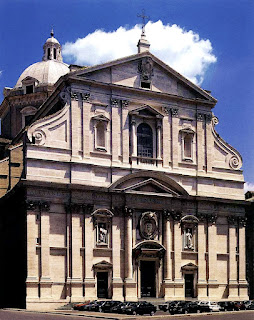I feel as though I have already
provided sufficient depth of inquiry (at least for the time being) on the
subject of paganism as an artistic element in Westernized or Christian art,
literature, and especially poetry. C. S.
Lewis has written most extensively on the topic of Myth's power to encompass
both the "sacred and profane," the divine and base, the Christian and
pagan. However, much of this writing was
done in my other, literary blog, and so I shall allude quickly to it again here
now with this next artist, Titian. Let us
observe the Bacchanal.
Remember Titian? He was the artist who painted The Concert and
the Venus of Urbino. He alludes often to
Greco-Roman ideals in his paintings, but that does not make them pagan, as is
the case here with the Bacchanal of the Andrians.
A bacchanal denotes a raucous party
held by Bacchus, who was the pagan god of wine in Ancient Greek mythology. As tradition follows, these pagan
celebrations were of the wildest nature in perhaps all literary history, almost
always including drunken orgies and other rowdy "romps," as C. S.
Lewis famously termed them in his Chronicles
of Narnia. In his time the professor
of Medieval and Renaissance Literature at Cambridge University, Lewis saw
prevalently in his studies of Malory, Chaucer, and other subjects of Medieval
study the infusion of pagan aspects into Christian stories. Perhaps most notably this begins with Beowulf and continues on to this day
with books like The Lion, the Witch, and
the Wardrobe. Lewis believed that
paganism and Christianity were in a way connected. How else does one explain the prevalence of
pagan elements in otherwise predominantly Christian texts and paintings during
this time? Western literature has often
borrowed from the pagan as a sort of foundational, ancestral root-point from
which could stem the holier, more definitive doctrines of Christendom. Lewis suggested that the idea of Bacchus, the
god of wine, was "the first, faint whisper" of something that
Christianity later became literally.
Bacchus represents wine in a mythical sense where Christ turned water
into wine in a literal sense. The
connections spring from this line of thought.
With this view in mind, we ought not be surprised to see paintings like
Titian's Bacchanal here appearing during the Counter Reformation (the
Catholics' response to the Protestant Reformation).
Though this painting features lewd
images not literally promoted by the Catholic Church, this was nonetheless a
painting to convey Catholic messages. The
allusion being made here is to something larger than the church itself. It harkens back to the archetypal celebration
held in tradition from the earliest ancestors of Ancient Greece. The same idea is being communicated, just in
different rites, through the passage of time.
No longer do people strip nude and get drunk on wine to party, but the
partying still occurs, to put it simply.
Joy is felt through different means, but joy still exists, timeless joy
that transcends contemporary custom. Titian's
painting is one of joy and celebration, hinting at the vivacious splendor and gaiety
(…ha) of the Catholic Church at this time as well as the happy welcome home
party awaiting any Catholic converts (recall Murillo's Return of the Prodigal
Son). Here we see some very strange
things going on, but the core idea behind it is one that is still familiar to
us today as it was during the 16th century. It is the timelessness of the Greek myth, the
Greek culture, often held as utopian, which resonates most powerfully, being
most ancient. Being expressed in this
painting is the fundamental concept of joy, joy which is implied to be
available on a divine level for those who would join the Holy Roman Empire.
It's often a difficult connection
to make. One almost cannot imagine a
painting like this one or Botticelli's Birth of Venus being put on display in
such a celibate and legalistic place as the Vatican. The reason is that the actual, physical
practices of the paintings are not being regarded (i.e., the nudity,
drunkenness, and…you know…whatever else is going on here…); rather, the age-old
ideas being expressed by those practices is the core of these works of
art. C. S. Lewis did the same thing in The Chronicles of Narnia when he added
such scenes of "romping" and partying, often including literal
references to the Greek and Roman gods.
He is not suggesting we all participate in specifically pagan rituals. It is to say that Christians experience joy
as well—that joy is not a monopolized experience to be held by one people, but
that someone else can come along, take that concept, and make it his own. Lewis made the pagan bacchanal celebration
almost Christian by placing it under the very Messianic character of Aslan. The ancient myths of parties were fulfilled
in Aslan, and the reference to the classical myths merely work to show the
historical totality of the concept. Here,
too, joy is tacked under the name of the pope in the Vatican to assert the joys
of embracing Catholicism.
If this doesn't make sense, don't
worry; we will get more into it later on.
As we will see, there is some trend for whatever reason for art through
the ages to consistently revert back to Greco-Roman ideals, as if to idolize
that time period and that historical culture.
Greek myths, Roman architecture, etc. will appear again and again nearly
as often as Keira Knightley appears in movies these days (seriously, she's in
all of 'em).


















